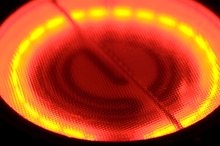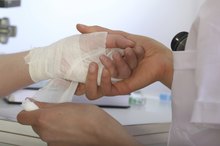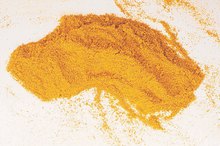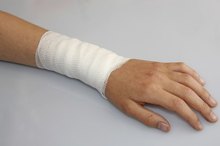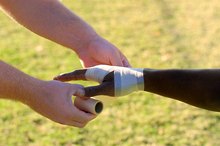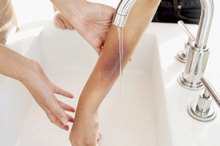What does fact checked mean?
At Healthfully, we strive to deliver objective content that is accurate and up-to-date. Our team periodically reviews articles in order to ensure content quality. The sources cited below consist of evidence from peer-reviewed journals, prominent medical organizations, academic associations, and government data.
The information contained on this site is for informational purposes only, and should not be used as a substitute for the advice of a professional health care provider. Please check with the appropriate physician regarding health questions and concerns. Although we strive to deliver accurate and up-to-date information, no guarantee to that effect is made.
Treatments for Iron Burns
One of the hazards of using an electric iron to smooth wrinkles out of your clothing is the risk of burning yourself. Most iron burns are minor and the treatments for them focus on pain relief and preventing infection and further damage to burned skin.
The Facts
A hot iron can burn your skin if you touch it. The severity of the burn depends on where the iron comes in contact with you and how long it touches your skin. A momentary touch on the edge of your hand may cause a minor burn that leaves a red mark and pain that quickly fades. But the flat side of the iron falling against the more delicate skin on the inside of your arm can cause a more severe burn. Treatments for iron burns are taken in stages 2.
- A hot iron can burn your skin if you touch it.
- But the flat side of the iron falling against the more delicate skin on the inside of your arm can cause a more severe burn.
Immediate Treatment
How to Treat an Oven Burn
Learn More
Immediately treating an iron burn can reduce the severity of the burn and improve your chances of escaping without infection or a scar. If you have a minor burn and your skin is unbroken, put the burned area in a cool-water bath or lay a cool, wet towel on your skin to relieve the pain. Do not apply ice to your skin, as that can cause more tissue damage. Do not apply butter to a burn.
- Immediately treating an iron burn can reduce the severity of the burn and improve your chances of escaping without infection or a scar.
- Do not apply ice to your skin, as that can cause more tissue damage.
Protection
After you have applied cooling relief to your iron burn and the pain has receded, the next stage of treatment is to protect the burn. Not only can pressure and friction on an iron burn cause pain, it can also cause more damage to your skin tissue and impede healing. Keep the burn covered with sterile gauze. If blisters develop, do not break them as this leaves them vulnerable to infection. When the burn has healed, cover it with sunscreen when you will be outside to help protect the new skin.
- After you have applied cooling relief to your iron burn and the pain has receded, the next stage of treatment is to protect the burn.
- When the burn has healed, cover it with sunscreen when you will be outside to help protect the new skin.
Pain Relief
How to Treat a Burn on a Forearm
Learn More
Iron burns can be painful. Protect the burn from rubbing or pressure to help prevent pain, and take over-the-counter pain relievers such as aspirin or acetaminophen as needed. Most minor burns do not require stronger pain management.
Severe Burns
Major iron burns are less common, but that is of little comfort if you experience one. Have someone drive you to urgent care or contact emergency services. In the interim, keep the burned area elevated and free from pressure or friction. Do not bathe the affected skin in water or apply any type of medication or ointment.
- Major iron burns are less common, but that is of little comfort if you experience one.
- In the interim, keep the burned area elevated and free from pressure or friction.
Related Articles
References
- MedlinePlus: Burns
- Mayo Clinic: First Aid for Burns
- Cuttle L, Pearn J, McMillan JR, Kimble RM. A review of first aid treatments for burn injuries. Burns. 2009;35(6):768-775. doi:10.1016/j.burns.2008.10.011
- Lloyd ECO, Rodgers BC, Michener M, Williams MS. Outpatient burns: prevention and care. Am Fam Physician. 2012;85(1):25-32.
- Shrivastava P, Goel A. Pre-hospital care in burn injury. Indian J Plast Surg. 2010;43(Suppl):S15-S22. doi:10.4103/0970-0358.70720
- Nielson CB, Duethman NC, Howard JM, Moncure M, Wood JG. Burns: Pathophysiology of Systemic Complications and Current Management. J Burn Care Res. 2017;38(1):e469-e481. doi:10.1097/BCR.0000000000000355
- Schaefer TJ, Tannan SC. Thermal Burns. In: StatPearls. Treasure Island, FL: StatPearls Publishing; 2019.
- Cancio LC, Barillo DJ, Kearns RD, et al. Guidelines for Burn Care Under Austere Conditions: Surgical and Nonsurgical Wound Management. J Burn Care Res. 2017;38(4):203-214. doi:10.1097/BCR.0000000000000368
- Lloyd ECO, Rodgers BC, Michener M, Williams MS. Outpatient burns: prevention and care. Am Fam Physician. 2012;85(1):25-32.
- Munteanu A, Florescu IP, Nitescu C. A modern method of treatment: The role of silver dressings in promoting healing and preventing pathological scarring in patients with burn wounds. J Med Life. 2016;9(3):306-315.
